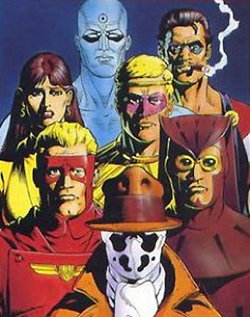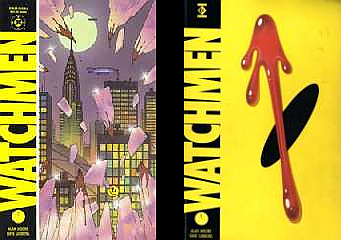Watchmen
Watchmen is a twelve-issue comic book written by Alan Moore and illustrated by Dave Gibbons. A limited series, originally published monthly by DC Comics in 1986-1987, it was later republished as a graphic novel. more...
Along with Frank Miller's The Dark Knight Returns and Art Spiegelman's Maus, Watchmen was considered a landmark of the genre, helping to bring back the adult audience comics mostly lost in the 1950s. Don Markstein wrote, "What The Maltese Falcon did for detective stories and Shane did for Westerns, Watchmen did for superheroes. It transcended its origins in what was previously considered a lowbrow form of fiction to provide a rich reading experience for all, whether they came in as fans of the genre or not."
Watchmen won numerous Kirby and Eisner awards from the comic industry, and won a special achievement Hugo Award in 1987, the only graphic novel to do so. In 2005, Time Magazine included it on a list of the 100 best novels from 1923 to the present.
Title
The title Watchmen refers to an excerpt from Juvenal's Satire VI Against Women:
- noui consilia et ueteres quaecumque monetis amici,
- "pone seram, cohibe".
- sed quis custodiet ipsos custodes
- cauta est et ab illis incipit uxor
A quite literal translation echoes the tone found in Moore's Watchmen:
- I hear always the admonishment of my friends:
- "Bolt her in, and constrain her!"
- But who will watch the watchmen?
- The wife arranges accordingly, and begins with them
Composition
Set in an alternative history in which superheroes are real, Watchmen is an adventure and crime drama that incorporates moral philosophy, popular culture, history, art, and science.
Watchmen is comprised of 12 chapters, which reproduce the original comic book issues. The beginning of each chapter, excluding the first, shows a clock face which progresses by a minute each issue; the second chapter begins at 11:49 ending at 12:00 in the final chapter. Each clock face may be seen as edging closer to the end of the world, in the vein of the Doomsday Clock. Quotes act as a footnote at the end of each chapter, their meaning pertaining to the events and tone of that chapter.
At the end of each chapter of Watchmen, essays and documents are included which serve to elaborate various aspects of the Watchmen world. Fictional newspaper reports, personal journals, and other articles help to clarify the myriad of backstories, and are utilized by Moore as a device to create a larger context within which the main narrative takes place. These include Rorschach's psychiatric medical records, the EC Comics-style pirate comic book running as a counterpoint to the larger narrative, and the fictitious far right-wing magazine, The New Frontiersman, which demonstates the political climate of this alternative United States history.
Plot summary
In October 1985, Walter Kovacs (Rorschach) investigates the murder of New York citizen Edward Blake. While searching Blake's apartment, Kovacs learns that Blake was also the costumed adventurer turned government agent known as The Comedian. Forming a theory that Blake's murder is the first in a plot to eliminate costumed adventurers, Kovacs extends warnings to four others still living in New York; Jon Osterman (Dr. Manhattan), Laurel Jane Juspeczyk (Silk Spectre II), Dan Dreiberg (Nite Owl II) and Adrian Veidt (Ozymandias). All but Osterman are now retired, due to the 1977 passage of the Keene Act, banning costumed vigilantes. Osterman was exempt because, like The Comedian, he was a U.S. government agent. Veidt had actually retired before the Keene Act and gone public as the real identity of Ozymandias, making himself a fortune in the process.
The world of Watchmen is dark and violent, with the United States and the Soviet Union edging toward a nuclear showdown. Ever since 1959, when a nuclear accident turned Osterman into the super-powered Dr. Manhattan, the U.S. has enjoyed a distinct strategic advantage over the Soviet Union. The United States' dominance over world affairs has allowed it to subjugate the Soviet Union, increasing global tension. In seeming anticipation of global war, American society has a general sense of fatalism about the future. Instances of this feeling pervade daily life, from "Meltdowns" candy to graffiti inspired by the Hiroshima bombing. This dim view of the nation's future results in an increasing reverence for the past, reflected in the success of "Nostalgia" aftershave.
Veidt, long retired and living as an incredibly rich corporate executive, had noticed Dr. Manhattan's increasing emotional detachment from humanity early on and formed a hypothesis that military expenditures, environmental damage and other problems will cause global catastrophe in the mid-nineties. As part of an elaborate plot to avert this, Veidt acts to increase Dr. Manhattan's isolation by secretly causing various cancers in former Osterman associates, while manipulating the press into speculating that Osterman himself is the cause; that he gave off radiation which was having some kind of carcinogenic effect. Moreover, Veidt orchestrates an assassination attempt upon himself in order to lend creedence to the theory of a plot to kill costumed adventures, while also diverting suspicion that he may be involved.
Dr. Manhattan teleports himself to Mars to consider recent events; his subsequent break with the U.S. government prompts Soviet opportunism in the form of an invasion of Afghanistan, greatly aggravating the global crisis. Rorschach is ambushed by police, arrested and sent to prison under the close scrutiny of a psychiatrist. Meanwhile, Silk Spectre II, Doctor Manhattan's abandonned lover, seeks companionship with Nite Owl II. Together, they concoct a plan to free Rorschach from prison in order to continue the investigation into the strange happenings with regards to costumed adventurers.
Read more at Wikipedia.org




